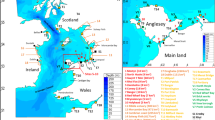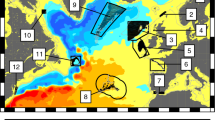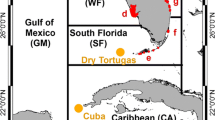Abstract
The localized scale of most fisheries management does not account for potential regional connectivity, particularly for fish species with prolonged planktonic larval durations (PLD). Although bonefish (Albula vulpes) inhabits shallow coastal habitats from juvenile through adult life stages, it is a strong candidate for population connectivity via larval dispersal with a PLD of 41–71 days. To address this knowledge gap, surface trajectories of particles (“virtual larvae”) released from 26 known and predicted spawning sites of bonefish around the Caribbean Sea, Florida, and Bahamas were simulated for 2009–2015 using a realistic ocean circulation hindcast model coupled with an online particle tracking simulator to study larval transport variations. At each site, 100 surface particles were released twice per month (at full and new moons) from October to April in each year and tracked for 53 days. We then estimated the likelihood that management regions would rely upon larval retention versus larval dispersal from other management zones. Overall, separately managed areas are likely to be connected via larval dispersal rather than entirely self-recruiting. Significant temporal differences in particle dispersal found for new and full moon phases, and between winter and spring, highlight that it is vital to resolve multiscale temporal and spatial variability in circulation transport when studying larval transport and connectivity. Results underscore the need to include the likelihood of population connectivity in fisheries management and conservation strategies, and to ensure that the ontogenetic habitat requirements of bonefish are properly managed at a regional scale.









Similar content being viewed by others
References
Adams AJ (2016) Guidelines for evaluating the suitability of catch and release fisheries: lessons learned from Caribbean flats fisheries. Fish Res. https://doi.org/10.1016/j.fishres.2016.09.027
Adams AJ, Murchie KJ (2015) Recreational fisheries as conservation tools for mangrove habitats. In: Murchie KJ, Daneshgar PP (eds) Mangroves as fish habitat, vol 83. American Fisheries Society, Symposium, Bethesda, pp 43–56
Adams AJ, Shenker J, Jud Z, Lewis JP, Danylchuk AJ (this issue) Identifying pre-spawning aggregation sites for bonefish (Albula vulpes) in the Bahamas to inform habitat protection and species conservation. Environ Biol Fish
Boucek RE, Lewis P, Stewart BD, Jud ZR, Adams AJ (this issue) Measuring site fidelity and homesite-to-pre-spawning site connectivity of Bonefish (Albula vulpes): using mark-recapture to inform habitat conservation. Environ Biol Fish
Brown CA, Jackson GA, Holt SA, Holt GJ (2005) Spatial and temporal patterns in modeled particle transport to estuarine habitat with comparisons to larval fish settlement patterns. Estuar Coast Shelf Sci 64:33–46. https://doi.org/10.1016/j.ecss.2005.02.004
Caldwell PC, Merrifield MA, Thompson PR (2015) Sea level measured by tide gauges from global oceans — the Joint Archive for Sea Level holdings (NCEI Accession 0019568), Version 5.5, NOAA National Centers for Environmental Information, Dataset, https://doi.org/10.7289/V5V40S7W
Castonguay M, McCleave JD (1987) Vertical distributions, diel and ontogenetic vertical migrations and net avoidance of leptocephali of Anguilla and other common species in the Sargasso Sea. J Plankton Res 9:195–214. https://doi.org/10.1093/plankt/9.1.195
Chapman DC (1985) Numerical Treatment of Cross-Shelf Open Boundaries in a Barotropic Coastal Ocean Model. J Phys Oceanogr 15:1060–1075. https://doi.org/10.1175/1520-0485
Claro R, Lindeman KC (2003) Spawning aggregation sites of Snapper and Grouper species (Lutjanidae and Serranidae) on the Insular Shelf of Cuba. Gulf and Caribbean Research 14:91–106
Colton DE, Alevizon WS (1983a) Feeding ecology of Bonefish in Bahamian waters. Trans Am Fish Soc 112:178–184
Colton DE, Alevizon WS (1983b) Movement patterns of the Bonefish (Albula vulpes) in Bahamian waters. US National Marine Fisheries Service Fishery Bulletin 81:148–154
Cowen RK, Paris CB, Srinivasan A (2006) Scaling of Connectivity in Marine Populations. Science 311:522–527. https://doi.org/10.1126/science.1122039
Crabtree RE, Harnden CW, Snodgrass D, Stevens C (1996) Age, growth, and mortality of bonefish, Albula vulpes, from the waters of the Florida Keys. Fish Bull 94:442–451
D’Aloia CC, Bogdanowicz SM, Francis RK, Majoris JE, Harrison RG, Buston PM (2015) Patterns, causes, and consequences of marine larval dispersal. Proc Natl Acad Sci U S A 112:13940–13945
Danylchuk AJ, Cooke SJ, Goldberg TL, Suski CD, Murchie KJ, Danylchuk SE, Shultz A, Haak CR, Brooks E, Oronti A, Koppelman JB, Philipp DP (2011) Aggregations and offshore movements as indicators of spawning activity of Bonefish (Albula vulpes) in the Bahamas. Mar Biol 158:1981–1999
Debreu L, Marchesiello P, Penven P, Cambon G (2012) Two-way nesting in split-explicit ocean models: Algorithms, implementation and validation. Ocean Model 49:1–21. https://doi.org/10.1016/j.ocemod.2012.03.003
Fairall CW, Bradley EF, Rogers DP, Edson JB, Young GS (1996) Bulk parameterization of air-sea fluxes for Tropical Ocean-Global Atmosphere Coupled-Ocean Atmosphere Response Experiment. J Geophys Res 101:3747–3764. https://doi.org/10.1029/95JC03205
Fedler A (2010) The economic impact of flats fishing in the Bahamas. Report to the Everglades Foundation, Palmetto Bay, Florida. https://www.bonefishtarpontrust.org/downloads/research-reports/stories/bahamas-flats-economic-impact-report.pdf
Fedler A (2013) Economic impact of the Florida Keys flats fishery. Report to Bonefish & Tarpon Trust, Key Largo Florida. https://www.bonefishtarpontrust.org/downloads/research-reports/stories/BTT%20-%20Keys%20Economic%20Report.pdf
Fedler A (2014) Economic impact of flats fishing in Belize. Report to Bonefish & Tarpon Trust, Key Largo, Florida. https://www.bonefishtarpontrust.org/downloads/research-reports/stories/2013-belize-economic-study.pdf
Flather RA (1976) A tidal model of the north-west European continental shelf. Memoires Societe Royale des Sciences de Liege 10:141–164
Gotelli NJ (1991) Metapopulation models: the rescue effect, the propagule rain, and the core-satellite hypothesis. Am Nat 138(3):768–776
Haak CR, Power M, Cowles G, Danylchuk A (this issue) Hydrodynamic and isotopic niche differentiation between juveniles of two sympatric cryptic bonefishes, Albula vulpes and Albula goreensis in The Bahamas. Environ Biol Bish
Haidvogel DB, Arango H, Budgell WP, Cornuelle BD, Curchitser E, Di Lorenzo E, Fennel K, Geyer WR, Hermann AJ, Lanerolle L, Levin J, McWilliams JC, Miller AJ, Moore AM, Powell TM, Shchepetkin AF, Sherwood CR, Signell RP, Warner JC, Wilkin J (2008) Ocean forecasting in terrain-following coordinates: Formulation and skill assessment of the Regional Ocean Modeling System. Journal of Computational Physics, Predicting Weather, Climate and Extreme Events 227:3595–3624. https://doi.org/10.1016/j.jcp.2007.06.016
Haley V (2009) Acoustic telemetry studies of Bonefish (Albula vulpes) movement around Andros Island, Bahamas: implications for species management. Master’s thesis. Florida International University, Miami
Hidalgo SE, Shima JS, Hellberg ME, Thorrold SR, Jones GP, Robertson DR, Morgan SG, Selkoe KA, Ruiz GM, Warner RR (2002) Evidence of self-recruitment in demersal marine populations. Bull Mar Sci 70:251–271
Holstein DM, Paris CB, Mumby PJ (2014) Consistency and inconsistency in multispecies population network dynamics of coral reef ecosystems. Mar Ecol Prog Ser 499:1–18. https://doi.org/10.3354/meps10647
Holden MJ, Raitt DFS (eds) (1974) Manual of Fisheries Science Part 2 – Methods of Resource Investigation and their Application. FAO, Rome, p 255
Kerr LA, Hintzen NT, Cadrin SX, Clausen LW, Dickey-Collas M, Goethel DR, Hatfield EMC, Kritzer JP, Nash RDM (2017) Lessons learned from practical approaches to reconcile mismatches between biological population structure and stock units of marine fish. ICES J Mar Sci. https://doi.org/10.1093/icesjms/fsw188
Kim H, Kimura S, Shinoda A, Kitagawa T, Sasai Y, Sasaki H (2007) Effect of El Niño on migration and larval transport of the Japanese eel (Anguilla japonica). ICES J Mar Sci 64:1387–1395. https://doi.org/10.1093/icesjms/fsm091
Klarenberg et al (this issue) Use of a dynamic population model to estimate mortality and recruitment trends for Bonefish in the Florida Keys. Environ Biol Fish
Kobara S, Heyman WD (2010) Sea bottom geomorphology of multi-species spawning aggregation sites in Belize. Mar Ecol Prog Ser 405:243–254. https://doi.org/10.3354/meps08512
Kobara S, Heyman WD, Pittman SJ, Nemeth RS (2013) Biogeography of transient reef-fish spawning aggregations in the Caribbean: a synthesis for future research and management. Oceanog Mar Biol: Annual Review 51:281–326
Kough AS, Claro R, Lindeman KC, Paris CB (2016) Decadal analysis of larval connectivity from Cuban snapper (Lutjanidae) spawning aggregations based on biophysical modeling. Mar Ecol Prog Ser 550:175–190. https://doi.org/10.3354/meps11714
Kough AS, Paris CB, Iv MJB (2013) Larval Connectivity and the International Management of Fisheries. PLoS One 8:e64970. https://doi.org/10.1371/journal.pone.0064970
Kovach AI, Breton TS, Berlinsky DL, Maceda L, Wirgin I (2010) Fine-scale spatial and temporal genetic structure of Atlantic cod off the Atlantic coast of the USA. Mar Ecol Prog Ser 410:177–195
Kroloff E, Heinen JT, Rehage J, Braddock K, Santos RO (this issue) A Key Informant Analysis of Local Ecological Knowledge and Perceptions of Bonefish Decline in South Florida. Environ Biol Fish
Kudo K (2001) Larval vertical-migration strategy of Japanese EEL. In: MTS/IEEE Oceans 2001. An Ocean Odyssey. Conference Proceedings (IEEE Cat. No.01CH37295). Presented at the MTS/IEEE Oceans 2001. An Ocean Odyssey. Conference Proceedings (IEEE Cat. No.01CH37295), pp. 870–875 vol. 2. https://doi.org/10.1109/OCEANS.2001.968231
Lett C, Verley P, Mullon C, Parada C, Brochier T, Penven P, Blanke B (2008) A Lagrangian tool for modeling ichthyoplankton dynamics. Environ Model Softw 23:1210–1214. https://doi.org/10.1016/j.envsoft.2008.02.005
Li Y, He R, Manning JP (2014) Coastal connectivity in the Gulf of Maine in spring and summer of 2004–2009. Deep Sea Research Part II: Topical Studies in Oceanography, Harmful Algae in the Gulf of Maine: Oceanography, Population Dynamics, and Toxin Transfer in the Food Web 103:199–209. https://doi.org/10.1016/j.dsr2.2013.01.037
Liu Y, Lee SK, Enfield DB, Muhling BA, Lamkin JT, Muller-Karger FE, Roffer MA (2015) Impact of global warming on the Intra-Americas Sea: part-1. A dynamic downscaling of the CMIP5 model projections. J Mar Syst 148:56–69
Marchesiello P, McWilliams JC, Shchepetkin A (2001) Open boundary conditions for long-term integration of regional oceanic models. Ocean Model 3:1–20. https://doi.org/10.1016/S1463-5003(00)00013-5
McClain CR, Hardy SM (2010) The dynamics of biogeographic ranges in the deep sea. Proceedings of the Royal Society of London B: Biological Sciences rspb20101057. https://doi.org/10.1098/rspb.2010.1057
McVeigh DM, Eggleston DB, Todd AC, Young CM, He R (2017) The influence of larval migration and dispersal depth on potential larval trajectories of a deep-sea bivalve. Deep Sea Res Part 1: Oceanographic Research Papers 127:57–64
Mojica R, Shenker JM, Harnden CW, Wanger DE (1995) Recruitment of Bonefish, Albula vulpes, around Lee Stocking Island, Bahamas. Fish Bull 93:666–674
Moon JH, Pang IC, Yang JY, Yoon WD (2010) Behavior of the giant jellyfish Nemopilema nomurai in the East China Sea and East/Japan Sea during the summer of 2005: A numerical model approach using a particle-tracking experiment. J Mar Syst 80:101–114. https://doi.org/10.1016/j.jmarsys.2009.10.015
Muhling BA, Liu Y, Lee SK, Lamkin JT, Roffer MA, Muller-Karger FE, Walter IIIJF (2015) Potential impact of climate change on the Intra-Americas Sea: Part-2. Implications for Atlantic bluefin tuna and skipjack tuna adult and larval habitats. J Mar Syst 148:1–13
North EW, Schlag Z, Hood RR, Li M, Zhong L, Gross T, Kennedy VS (2008) Vertical swimming behavior influences the dispersal of simulated oyster larvae in a coupled particle-tracking and hydrodynamic model of Chesapeake Bay. Mar Ecol Prog Ser 359:99–115. https://doi.org/10.3354/meps07317
Orlanski I (1976) A simple boundary condition for unbounded hyperbolic flows. J Comput Phys 21:251–269. https://doi.org/10.1016/0021-9991(76)90023-1
Paris CB, Cowen RK, Claro R, Lindeman RC (2005) Larval transport pathways from Cuban snapper (Lutjanidae) spawning aggregations based on biophysical modeling. Mar Ecol Prog Ser 296:93–106
Paris CB, Helgers J, van Sebille E, Srinivasan A (2013) Connectivity Modeling System: A probabilistic modeling tool for the multi-scale tracking of biotic and abiotic variability in the ocean. Environ Model Softw 42:47–54. https://doi.org/10.1016/j.envsoft.2012.12.006
Putman NF, He R (2013) Tracking the long-distance dispersal of marine organisms: sensitivity to ocean model resolution. J R Soc Interface 10:20120979. https://doi.org/10.1098/rsif.2012.0979
Putman NF, Mansfield KL, He R, Shaver DJ, Verley P (2013) Predicting the distribution of oceanic-stage Kemp’s ridley sea turtles. Biol Lett 9:20130345. https://doi.org/10.1098/rsbl.2013.0345
Qian H, Li Y, He R, Eggleston DB (2014) Connectivity in the Intra-American Seas and implications for potential larval transport. Coral Reefs 34:403–417. https://doi.org/10.1007/s00338-014-1244-0
Rehage JS, Santos RO, Kroloff EKN, Heinen JE, Lai Q, Black B, Boucek RE, Adams AJ (this issue) How has the quality of bonefishing changed? Quantifying temporal patterns in the South Florida Flats Fishery using local ecological knowledge. Environ Biol Fishes
Roberts CM (1997) Connectivity and Management of Caribbean Coral Reefs. Science 278:1454–1457. https://doi.org/10.1126/science.278.5342.1454
Sadovy De Mitcheson YS, Cornish A, Domeier M, Colin PL, Russell M, Lindeman KC (2008) A global baseline for spawning aggregations of reef fishes. Conserv Biol 22(5):1233–1244
Santos R, Rehage JS, Adams AJ, Black BD, Osborne J, Kroloff EKN (2017) Quantitative assessment of a data-limited recreational bonefish fishery using a timeseries of fishing guides reports. PLoS One 12(9):e0184776. https://doi.org/10.1371/journal.pone.0184776
Santos, RO, Rehage JS, Kroloff EKN, Heinen JE, Adams AJ (this issue) Combining data sources to elucidate spatial patterns in 1 recreational catch and effort: fisheries-dependent data and local ecological knowledge applied to the South Florida bonefish fishery. Environ Biol Fishes
Shchepetkin AF, McWilliams JC (2005) The regional oceanic modeling system (ROMS): a split-explicit, free-surface, topography-following-coordinate oceanic model. Ocean Model 9:347–404. https://doi.org/10.1016/j.ocemod.2004.08.002
Sikirić MD, Janeković I, Kuzmić M (2009) A new approach to bathymetry smoothing in sigma-coordinate ocean models. Ocean Model 29:128–136. https://doi.org/10.1016/j.ocemod.2009.03.009
Truelove NK, Kough AS, Behringer DC, Paris CB, Box SJ, Preziosi RJ, Butler MJ (2017) Biophysical connectivity explains population genetic structure in a highly dispersive marine species. Coral Reefs 36(1):233–244
Wallace EM, Tringali MD (2016) Fishery composition and evidence of population structure and hybridization in the Atlantic bonefish species complex (Albula spp.). Mar Biol 163:142. https://doi.org/10.1007/s00227-016-2915-x
Warner RR, Chesson PL (1985) Coexistence mediated by recruitment fluctuations: a field guide to the storage effect. Am Nat 125(6):769–787
Warner JC, Sherwood CR, Arango HG, Signell RP (2005) Performance of four turbulence closure models implemented using a generic length scale method. Ocean Model 8:81–113. https://doi.org/10.1016/j.ocemod.2003.12.003
Williamson DH, Harrison HB, Almany GR, Berumen ML, Bode M, Bonin MC, Choukroun S, Doherty PJ, Frisch AJ, Saenz-Agudelo P, Jones GP (2016) Large-scale, multidirectional larval connectivity among coral reef fish populations in the Great Barrier Reef Marine Park. Mol Ecol 25:6039–6054
Xue H, Incze L, Xu D, Wolff N, Pettigrew N (2008) Connectivity of lobster populations in the coastal Gulf of Maine: Part I: Circulation and larval transport potential. Ecol Model 210:193–211. https://doi.org/10.1016/j.ecolmodel.2007.07.024
Yin Y, Lin X, Li Y, Zeng X (2014) Seasonal variability of Kuroshio intrusion northeast of Taiwan Island as revealed by self-organizing map. Chin J Oceanol Limnol 32:1435–1442. https://doi.org/10.1007/s00343-015-4017-x
Young CM, He R, Emlet RB, Li Y, Qian H, Arellano SM, Van Gaest A, Bennett KC, Wolf M, Smart TI, Rice ME (2012) Dispersal of deep-sea larvae from the intra-American seas: simulations of trajectories using ocean models. Integr Comp Biol 52:483–496. https://doi.org/10.1093/icb/ics090
Zeng X, He R (2016) Gulf Stream variability and a triggering mechanism of its large meander in the South Atlantic Bight. J Geophys Res Oceans 121:8021–8038. https://doi.org/10.1002/2016JC012077
Zeng X, Li Y, He R, Yin Y (2015a) Clustering of Loop Current patterns based on the satellite-observed sea surface height and self-organizing map. Remote Sensing Letters 6:11–19. https://doi.org/10.1080/2150704X.2014.998347
Zeng X, He R, Xue Z, Wang H, Wang Y, Yao Z, Guan W, Warrillow J (2015b) River-derived sediment suspension and transport in the Bohai, Yellow, and East China Seas: A preliminary modeling study. Continental Shelf Research, Coastal Seas in a Changing World: Anthropogenic Impact and Environmental Responses 111:112–125. https://doi.org/10.1016/j.csr.2015.08.015
Zeng X, Li Y, He R (2015c) Predictability of the Loop Current Variation and Eddy Shedding Process in the Gulf of Mexico Using an Artificial Neural Network Approach. J Atmos Ocean Technol 32:1098–1111. https://doi.org/10.1175/JTECH-D-14-00176.1
Zhang WG, Wilkin JL, Levin JC, Arango HG (2009) An Adjoint Sensitivity Study of Buoyancy- and Wind-Driven Circulation on the New Jersey Inner Shelf. J Phys Oceanogr 39:1652–1668. https://doi.org/10.1175/2009JPO4050.1
Acknowledgements
Research support provided by Bonefish and Tarpon Trust; NSF grants: OCE1029841, OCE1559178; NOAA grants: NA11NOS0120033, NA14NMF4540061, NA16NOS0120028; NASA grants: NNX10AU06G, NNX12AP84G, NNX13AD80G, NNX14AO73G; The Gulf of Mexico Research Initiative Grant 2015-V-487 are much appreciated.
Author information
Authors and Affiliations
Corresponding author
Rights and permissions
About this article
Cite this article
Zeng, X., Adams, A., Roffer, M. et al. Potential connectivity among spatially distinct management zones for Bonefish (Albula vulpes) via larval dispersal. Environ Biol Fish 102, 233–252 (2019). https://doi.org/10.1007/s10641-018-0826-z
Received:
Accepted:
Published:
Issue Date:
DOI: https://doi.org/10.1007/s10641-018-0826-z




